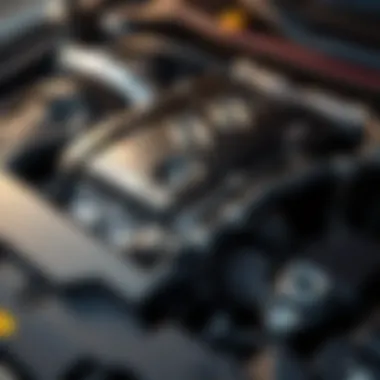Understanding Full Coverage Insurance for Mechanical Issues


Intro
When you hear the term "full coverage insurance," it can be a bit like hearing a foreign language at first. Many people think they understand it, but there's often a maze of details hiding behind the simplicity of the phrase. Full coverage typically refers to a combination of liability, collision, and comprehensive insurance. However, mechanical issues related to your vehicle often dance outside the boundaries of traditional coverage. For the average car owner—especially young professionals or small business owners—grasping the dynamics of automotive insurance can feel like trying to hit a moving target.
Understanding how full coverage applies to mechanical issues is crucial because it not only affects your wallet but also determines your peace of mind while driving. Many believe that if they have full coverage, they’re shielded against all problems. But this isn't always the case—mechanical failures can often fall through the cracks of an insurance policy, leaving car owners feeling betrayed when the bills start piling up.
This article aims to decode that complexity. We will delve into the types of mechanical failures, the real implications of your coverage choices, and when you should find another path for protection. By the end of our exploration, you'll have a clear picture that will inform your decisions and potentially save you from financial pitfalls.
Preface to Full Coverage Insurance
Many drivers think they understand full coverage insurance, but in reality, it encompasses much more than what meets the eye. This section sheds light on why grasping this concept is crucial for automotive insurance consumers. Full coverage insurance typically implies that your vehicle is protected against various forms of damage, both caused by you and others. It might sound like a blanket of safety, but understanding its limitations and components can save you from unexpected financial woes down the road.
Definition of Full Coverage Insurance
Full coverage insurance is a term used to describe an auto insurance policy that combines several coverage types. While there's no universal definition—because insurance policies vary widely from provider to provider—going by the general understanding, it means you have both liability and protection for your vehicle itself. This can include collision coverage, comprehensive coverage, and often uninsured motorist coverage.
However, it’s imperative to remember that "full coverage" doesn’t mean all of your potential risks are covered. It’s more of an umbrella term rather than a specific policy.
Components of Full Coverage Insurance
Understanding the components of full coverage can help you delve deeper into its offerings. This could spell the difference between financial shelter and a harsh reality of out-of-pocket expenses.
Liability Coverage
Liability Coverage is often the most fundamental element. This type of coverage kicks in when you’re responsible for an accident causing injury or damage to someone else’s property. The key characteristic is that it covers the costs associated with lawsuits or claims made against you, which is why it's mandated by law in most states.
This type of coverage is not just popular—it’s crucial for anyone looking to drive legally and responsibly. A unique feature to make note of is that liability coverage caps differ from state to state, with minimum requirements typically being quite low. Thus, going beyond the bare minimum could be a beneficial move for peace of mind.
Collision Coverage
Collision Coverage comes into play if your car collides with another vehicle or object, fulfilling the essential need for protection against accidental damage. The standout characteristic here is that it helps bridge the gap between the loss of your vehicle’s value and the cost of repair or replacement.
It's a favorable choice for drivers who want that extra layer of safety during unforeseen events. However, keep in mind that you'll still need to pay a deductible—this aspect can sometimes serve as a disadvantage, especially for those who may feel the premiums are already hefty.
Comprehensive Coverage
In addition, there’s Comprehensive Coverage, which deals with a range of issues, from natural disasters like floods and fire to vandalism and theft. This type is essential for drivers wanting to safeguard against more than just collisions. Its key characteristic is the extensive range of damage it covers, making it a wise option for people living in certain areas prone to specific risks.
However, one must consider that the premium for comprehensive coverage can be a bit on the higher side, which could deter some. On the flip side, if anything does occur, you'd be grateful to have that layer of protection in place.
To recap, understanding these components provides clarity on what full coverage truly entails. It’s not merely a checkbox on a form; it’s a medley of protections designed to enrich your driving experience and safeguard your assets. In the following sections, we will delve into the nuances of mechanical issues and the intersection with your full coverage policy.
Understanding Mechanical Issues
In the realm of automobile ownership, comprehending mechanical issues is crucial for both safety and financial viability. Mechanical failures, if left unchecked, can morph into significant dilemmas, potentially leading to excruciating repair bills and unsafe driving conditions. Gaining insight into what constitutes a mechanical failure empowers vehicle owners to take proactive measures. It allows them to recognize the signs of trouble before their vehicle breaks down, ultimately protecting their investment and ensuring their vehicles run smoothly. This knowledge is indispensable, especially in the context of understanding full coverage insurance, which may not cover certain mechanical malfunctions.
What Constitutes Mechanical Failure?
Mechanical failure can generally be defined as the inability of a vehicle's components to perform their intended function. This can stem from various factors such as wear and tear, faulty installation, or even manufacturing defects. Essentially, if a part of your vehicle stops working as it should, it qualifies as mechanical failure. The intricacies of mechanical issues can affect your overall car experience—from how it drives to how much money you might sink into repairs.
Common Types of Mechanical Problems
Several types of mechanical problems can plague vehicle owners. Being conversant with these issues not only prepares you to deal with them but also aids in understanding your insurance coverage, or the lack thereof.
Engine Failures


Engine failures represent one of the greastest concerns for vehicle owners. These failures could emanate from numerous causes such as overheating or oil leaks. A key characteristic of engine failures is their often sudden nature. One moment, everything feels just fine, and the next, the check engine light is flashing, leaving you stranded.
The unique feature of engine failures is their unpredictability. You might catch minor signs, such as unusual noises or reduced power, but major breakdowns can strike without much warning. Repair costs can easily spiral into the thousands, making it a significant aspect to consider when evaluating your coverage. If your auto insurance doesn't cover these mechanical issues, you could find yourself in a financial pickle.
Transmission Issues
Transmission issues can also become a headache for many drivers. This specific mechanical failure usually manifests as slipping gears or difficulty changing gears, signaling potentially significant problems. The primary characteristic here is that if the transmission goes, you may not be able to drive your vehicle at all.
A notable feature about transmission issues is their complexity. Repair costs tend to be high, and many times, a complete transmission replacement becomes necessary. If your full coverage insurance policy doesn't address these issues, owners might need to look into other options for financial protection, like Mechanical Breakdown Insurance.
Electrical System Failures
Electrical system failures are increasingly becoming common with the rise of advanced automotive technology. These failures can affect various functions in the vehicle, from the ignition system to dashboard indicators. A key feature of electrical failures is how they may not manifest as prominently as other mechanical failures. You might have trouble starting the car one day, only for everything to function normally the next.
What makes electrical issues particularly tricky is their multifaceted nature. Problems can stem from dead batteries, faulty sensors, or even short circuits. Without coverage for such failures, the cost of repairs can add up quickly. Understanding these mechanical intricacies not only informs your insurance decisions but also ensures you stay ahead of any potential car troubles.
Does Full Coverage Insurance Include Mechanical Failures?
When it comes to automotive insurance, clarifying the relationship between full coverage insurance and mechanical failures is substantial. Many individuals operate under a misunderstanding that full coverage lines of protection automatically extend to cover any mechanical issues that might arise with their vehicles. This section aims to sift through those misconceptions and unearth the reality behind what full coverage really entails regarding mechanical malfunctions.
Coverage Gaps in Full Coverage Insurance
It's crucial to recognize that while full coverage insurance provides a safety net for various incidents, it doesn’t necessarily encompass mechanical failures. Typically, this type of insurance includes liability, collision, and comprehensive coverage, but these coverages primarily protect against accidents, theft, and damages from external causes.
The needs of a vehicle can change, and some common coverage gaps may include :
- Wear and Tear: Regular wear on parts isn’t covered; insurance only kicks in due to sudden failures.
- Routine Maintenance: Costs associated with regular services such as oil changes and tire rotations are not part of any coverage.
- Manufacturing Defects: Issues that arise from production flaws generally fall outside the umbrella of standard insurance protection.
Understanding these gaps helps vehicle owners make informed decisions about obtaining additional coverage specifically designed for mechanical problems.
Factors Affecting Coverage for Mechanical Issues
Understanding the nuances surrounding coverage for mechanical issues is complicated. Several factors can significantly influence what is covered under your full coverage policy.
Policy Details
The intricacies of policy details define what your insurance company is willing to cover. Every policy is unique, reflecting the provider’s specific terms and conditions. Among them, exclusions for mechanical failures is often included, so reading the fine print is essential. This can save a world of headaches. For instance, a unique characteristic many policy details emphasize is the clause that indicates coverage only for sudden and accidental damages.
This careful framing is beneficial; however, it can lead to denial of claims outside those sudden incidents. Thus, knowing your policy intimately enables you to anticipate coverage limitations.
Duration of Coverage
Duration of coverage plays a pivotal role in how mechanical concerns are managed. Many full coverage policies have specified timeframes during which they remain active. A notable feature here is that the warranty period for new vehicles often provides additional peace of mind, as much as three to five years depending on the manufacturer. Having ongoing coverage can mitigate some repair expenses over time.
However, as the vehicle ages, many may experience a shift where insurance might not cover repair or replacement for certain mechanical failures. This brings to light the necessity of evaluating time-sensitive terms and understanding when exactly your coverage lapses.
Vehicle Age and Condition
The age and condition of a vehicle hold significant sway over coverage for mechanical issues. As vehicles get older, they tend to encounter more frequent mechanical problems. This aspect typically leads to increased repair costs which may not be covered under a standard full coverage policy. An important characteristic of older models is that they may not qualify for certain coverages, rendering the owner financially responsible for any mechanical concerns.
Moreover, vehicle condition compels owners to contemplate additional protections like mechanical breakdown insurance to bridge any uncovered gaps. Understanding these elements allows consumers to balance their risks and avoid hefty financial burdens down the road.
"Always read your insurance policy carefully; not all coverage is created equal, and knowing what is excluded can save you from costly surprises later on."
By breaking down these vital aspects of full coverage insurance and mechanical failures, vehicle owners can better navigate their insurance choices, ensuring they stay ahead of any potential issues.
Claims Process for Mechanical Issues


Navigating the claims process for mechanical issues is critical for vehicle owners who expect their insurance policies to provide support when things go south. The claims process helps ensure that your mechanical failures are resolved efficiently and that you do not bear the financial burden alone. Understanding the steps involved can empower policyholders, allowing them to advocate for their rights effectively.
This part of the article will discuss the necessary steps to file a claim successfully, the documentation you will need, and what to expect throughout the process.
Filing a Claim for Mechanical Problems
Filing a claim for mechanical problems can seem daunting, but breaking it down into manageable steps can make it much easier. It typically starts with the identification of the issue, whether it's an engine hiccup or a transmission meltdown, and contacting your insurer right away. The quicker you report the problem, the better your chances of having a smooth claims process.
When reaching out to the insurance company, be sure to provide complete information about your vehicle and the specific issue at hand. This not only streamlines the process but also sets a professional tone from the get-go.
Key Steps to File a Claim:
- Gather comprehensive details of the mechanical issue.
- Contact your insurance provider as soon as possible.
- Submit necessary forms and information as directed by your insurer.
- Follow up to ensure that your claim is being processed.
Documentation Required for Claims
Documentation is the backbone of a successful insurance claim. Without the right papers, you might find yourself wishing you had kept better records. Here are the essential documents you need to gather:
Inspection Reports
Inspection reports are crucial when filing claims for mechanical issues. These documents offer a detailed look at the state of your vehicle and serve as evidence to support your claim. An inspection report typically contains the diagnostic results, findings from a technician, and recommendations for repairs.
The clarity and thoroughness of these reports are one of the distinguished characteristics that make them highly beneficial in claims processes. They establish a factual basis for your claim, reducing the chance of disputes with the insurer. The unique feature of inspection reports is that they often include visual evidence, such as photographs of the damaged components, adding credibility to your case.
However, one must be cautious. Not all mechanics will provide the same level of detail, and if the report lacks adequate information, it might not be as useful as hoped.
Repair Estimates
Repair estimates tend to outline the cost required to get your vehicle back on the road. This document will specify the necessary repairs and the associated expenses, based on a mechanic's evaluation.
The key characteristic of repair estimates is their focus on financial aspects, which assists in calculating potential payouts from the insurance company. Providing a detailed repair estimate makes your claim more credible and helps avoid back-and-forth that could delay the process.
A unique feature of repair estimates lies in the fact that they can vary from one repair shop to another. Always opt for estimates from reputable mechanics, as discrepancies can lead to disputes with your insurer.
Maintenance Records
Maintenance records are vital for showcasing that you have kept up with your vehicle's needs. These records can demonstrate due diligence on your part, showing that you were proactive in maintaining the vehicle. It’s beneficial in establishing that the mechanical failure was not due to negligence.
Key point: Maintenance records include receipts for oil changes, tire rotations, and any significant repairs.
The advantage of having thorough maintenance records is that they can make it difficult for insurers to deny your claim based solely on vehicle neglect. However, if the records are inconsistent or incomplete, it may raise questions about your maintenance habits.
In summary, the claims process for mechanical issues can majorly impact the financial outcome for vehicle owners. Being prepared with the proper documentation can make this process less overwhelming and ensure you have the best chance of a favorable resolution.
Alternative Coverage Options
When considering automotive coverage, understanding alternative options beyond full coverage insurance is essential. For many drivers, full coverage may not adequately protect against all potential issues, particularly mechanical failures. This section will explore two alternatives––Mechanical Breakdown Insurance and Extended Warranties––that can enhance your vehicle protection strategy.
Mechanical Breakdown Insurance
Mechanical Breakdown Insurance (MBI) functions a bit like your typical extended warranty but with critical differences. This type of coverage specifically targets repair costs for mechanical issues that arise post-purchase, and it often comes with fewer limitations than traditional warranties.
- Robust Coverage: MBI usually covers a wide array of mechanical parts, including the engine, transmission, and even electrical systems, which are commonly excluded from standard policies.
- Flexibility: Unlike traditional auto insurance, which typically covers only accident-related damages, MBI kicks in when everyday wear-and-tear leads to breakdowns. This can be especially beneficial for anyone relying heavily on their vehicle.
- Peace of Mind: One of the prime benefits of Mechanical Breakdown Insurance is the reassurance that if something goes wrong, you won't face an unexpected out-of-pocket expense that could throw your finances into disarray.
However, it’s crucial to pay attention to the fine print. Policies may differ in what they cover, deductibles might apply, and there may be limits on the duration or the conditions under which the coverage applies. Don't hesitate to clarify these details with your insurance provider.


Extended Warranties
Extended warranties offer another layer of protection that can be appealing, especially for drivers with newer vehicles. They can vary widely in their structure and terms, providing a chance to tailor coverage to your specific needs.
- Customization: Extended warranties can often be customized to fit the specific make and model of your vehicle, covering various components from the engine to roadside assistance.
- Transferability: Should you decide to sell your car, many extended warranties are transferable to the new owner, potentially increasing the resale value.
- Budgeting: Paying for an extended warranty can help in predicting future repair costs. Instead of facing potentially large repair bills, you can pay a regular fee, keeping your budget more predictable.
Despite these benefits, extended warranties often carry terms that might not align with your needs. They can also be more expensive than expected, with some policies featuring high deductibles and limits on coverage duration.
Important Note: Always read the fine print when it comes to any automotive coverage like MBI or extended warranties. Know what you're signing up for to avoid unpleasant surprises later on.
In summary, exploring alternative coverage options like Mechanical Breakdown Insurance and Extended Warranties can provide greater overall protection for vehicle owners. With thorough research and clear understanding, drivers can select the right mix of insurance and warranties that best suits their individual needs and circumstances.
Evaluating Your Insurance Needs
Understanding your insurance needs isn't just a box to tick; it's a vital step that can lead to significant savings and peace of mind. Especially when it comes to full coverage insurance with its various intricacies, making sure you have the right policy tailored to your specific situation can be a game-changer. This section sheds light on key elements that play a crucial role in evaluating your insurance needs.
Assessing Vehicle Usage and Condition
The first thing you ought to consider is how you use your vehicle. Are you a daily commuter, or do you occasionally take it out for road trips? Perhaps you’re running a small business and using your vehicle for deliveries. Each usage scenario has its own risks and considerations necessitating a tailored coverage approach.
A few elements to think about include:
- Mileage: Higher mileage could increase the odds of mechanical breakdowns.
- Environment: Do you typically drive through city streets or rugged rural roads? The conditions may impact wear and tear.
- Vehicle Type: Luxury cars might come with more specialized mechanical issues than a compact sedan.
The condition of your vehicle is equally important to evaluate. An older vehicle may have existing issues, which could require more comprehensive coverage, particularly if parts and repairs are more costly.
Consulting with Insurance Professionals
Once you’ve taken a good, hard look at your vehicle and how it fits into your daily life, the next step is to speak with professionals. Insurance isn’t a one-size-fits-all market; chatting about your specific situation can yield surprising benefits and tailor-fit your policy.
Here are some points to consider when consulting with insurance professionals:
- Experience and Knowledge: Some agents specialize in certain types of coverage, especially those that deal with mechanical issues.
- Questions to Ask: Inquire not just about what is covered, but what isn't, especially involving mechanical breakdowns.
- Policy Recommendations: Based on your vehicle's usage and condition, the professional can propose adjustments/additions.
"Informed decisions can pave the way for better coverage and financial security."
By evaluating your insurance needs thoroughly and consulting with knowledgeable agents, you set yourself up for success. This proactive approach can help ensure that you are adequately protected against both external risks and potential mechanical failures.
End: Making Informed Choices
Navigating through the realm of full coverage insurance can feel like trying to find a needle in a haystack for many vehicle owners. It’s a crucial aspect of responsible car ownership, especially when considering mechanical issues that may arise unexpectedly. This section highlights the importance of being well-informed about your insurance options and the potential gaps that could affect your financial security.
When assessing your insurance needs, it’s essential to grasp the limitations inherent in full coverage policies. While these policies offer a broad safety net, they usually don't cover mechanical failures caused by normal wear and tear. For example, if your vehicle suffers from engine trouble that’s a result of a lack of maintenance, full coverage won’t foot the bill. Understanding these nuances allows you to make choices that align with your financial strategy, rather than leaving you exposed to unforeseen expenses.
Understanding the Limitations of Full Coverage Insurance
Full coverage insurance typically includes liability, collision, and comprehensive coverage, but it does have its limits. Many drivers mistakenly assume that this type of coverage will take care of all mechanical problems, which simply isn’t the case. In essence, full coverage is more about protecting against damages to or by your vehicle in accidents, theft, or vandalism rather than mechanical failures.
Here’s a quick breakdown of these limitations:
- Liability Coverage: Pays for damages to another person's property or bodily injuries. It doesn’t cover your vehicle’s mechanical issues.
- Collision Coverage: Covers damages to your own vehicle from an accident but not from general wear and tear or a malfunction.
- Comprehensive Coverage: Protects against non-collision-related damages (like theft or natural disasters) but will not address mechanical failures.
Knowing these specifics allows you to avoid unpleasant surprises. It’s also wise to review your policy annually. Change in vehicle conditions, usage patterns, or even your lifestyle can demand adjustments to your coverage.
Empowering Consumers for Financial Decisions
Being proactive is key here. Understanding the ins and outs of your insurance can empower you to make informed financial decisions. This not only translates to better coverage for mechanical issues but can also lead to potential cost savings.
Consider adopting a few strategies:
- Thoroughly Research Options: Educate yourself about various policies on the market and their specifics regarding mechanical issues. Websites like britannica.com can provide additional insights.
- Consult Professionals: Consider discussing your options with an insurance agent who can clarify any doubts and offer personalized recommendations.
- Invest in Alternate Coverage: Depending on your situation, it might be beneficial to look into mechanical breakdown insurance or extended warranties tailored to cover those dreaded car repairs that your full coverage policy leaves on the table.
Ultimately, knowledge is power. By grasping the intricacies of full coverage insurance, you put yourself in a position to not just react to issues as they arise, but to strategize and plan effectively. Empower yourself with knowledge and ensure that you're making choices that protect you and your pocketbook in the long run.



